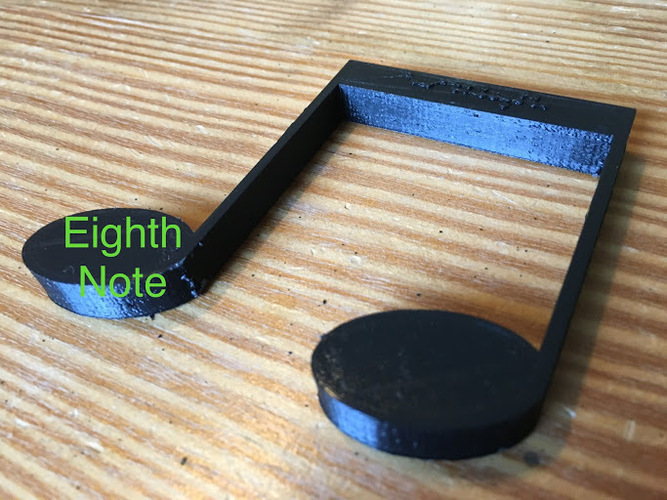
Music Notes for Visually Impaired
pinshape
Scroll down to the bottom for a summary of all this and print settings. Hello! Allow me to introduce myself. My name is Erik Johnson, and I'm a Freshman (9th grade) student at Vernon Hills High School in the Chicagoland Area. I've always had an interest in 3D printing and electronics since I was just a kid. I've been playing the Trumpet since 5th grade, and I just started with the French Horn. What is it exactly? This project consists of 4 different designs (for now; I plan to add more in the future when I have more time after school is out of session). The designs are different notes used for composition of music in orchestras, bands, and choirs. These notes represent a different amount of a measure you play a certain tone in the music. All of the notes have braille lettering incorporated into them. The braille lettering is incorporated in a way that it doesn't disrupt the actual shape of the note. The first one is an eighth note; it looks like two small quarter notes connected by a line. In music, you play this for an eighth of a measure, depending upon what your time signature is. The second design is a quarter note; it looks like a lowercase "b" that's filled in. In music, you play this note for a quarter of a measure, depending upon what your time signature is. The third design is a half note. The half note looks like a lowercase "d." In music composition and reading, this means that you play for, you guessed it, a half of a measure. The last design is a whole note; it looks like an italicized "o" You play this note for the full length of a measure. How did I come up with the idea? About a month ago, I was sitting in band and somehow we got on the topic about how you can't feel music, and I didn't really think much of that phrase until I saw this contest and then it hit me. People who have impaired vision can't really read music. From there, I did a bit of research and found out that many people with visual impairments find it difficult to learn music due to the lack of tactile feedback. How did I create these designs? I used Tinkercad, an easy-to-use online CAD software, to design these models. I followed the standards set in the reference sheet at the contest page for braille lettering. The designs are very simple and can be easily printed on a 3D printer. What's the use? These models are designed to be used in a school or educational environment that wants to teach people who don't know much about music. These can be implemented into classroom curriculums and even just used for playing around with. You can print out multiple of these, play a simple music sample, and have students make the rhythm out of the notes. Designs I am leaving the designs as open-source so that teachers and students can go ahead and tweak the design to their liking with the easy website Tinkercad, or even export it into their CAD software of choice. Here are the links to the Tinkercad designs: * Eighth Note: https://www.tinkercad.com/things/ * Quarter Note: https://www.tinkercad.com/things/ * Half Note: https://www.tinkercad.com/things/ * Whole Note: https://www.tinkercad.com/things/ Summary These designs are different music notes with braille lettering on them. They are very easy to print and if you would like to tinker with the design, the links to the Tinkercad designs are above. Print Settings Quality/Layer Height: 0.15mm or smaller Perimeters: Doesn't matter Infill: I used 20%, but any should work Supports: None! Scaling: 100% to keep braille text at its necessary size Build Adhesion: Whatever works best for your build plate/printer (I used skirt with gaff tape on the heated plate) Feel free to mess around with settings and post what works for you in the comments! Thank you for taking the time to look at my design! I know that this is a simple design. I wanted to keep the design simple enough for anybody to go in and edit the design and make it to their specifications. I also wanted to make it extremely easy to print. It is simple by design. Also, I plan to add more designs for notes, time signatures, and tempos. Please comment down below if you would like to see anything specific, and I will do my best to try and make it happen! Ignore the stringing marks on my prints; those are from my printer itself, and are not in the model. Link to video:
With this file you will be able to print Music Notes for Visually Impaired with your 3D printer. Click on the button and save the file on your computer to work, edit or customize your design. You can also find more 3D designs for printers on Music Notes for Visually Impaired.
